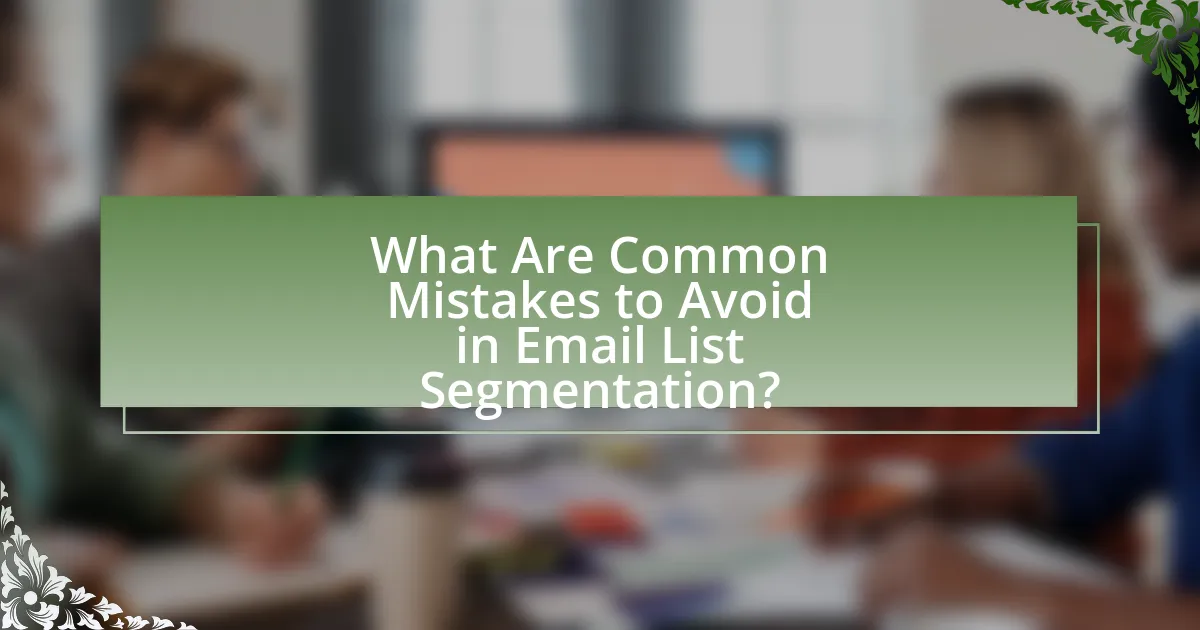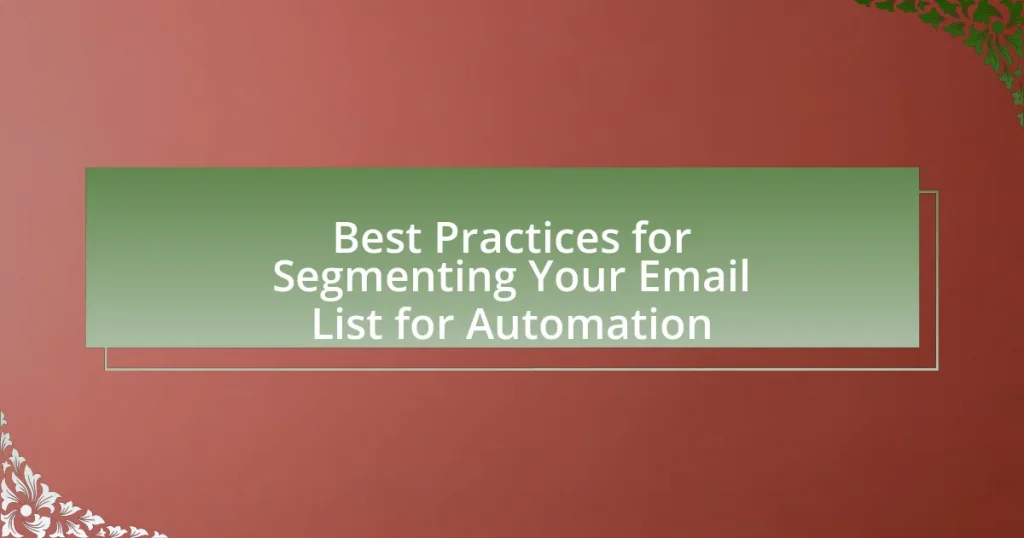The article focuses on best practices for segmenting email lists to enhance automation in marketing strategies. It emphasizes the importance of defining clear criteria for segmentation based on demographics, behavior, and engagement levels, which can significantly improve engagement and conversion rates. Key insights include the effectiveness of targeted messaging, the role of demographic and behavioral data, and the necessity of regularly updating segments to maintain relevance. Additionally, the article discusses common pitfalls to avoid, tools for automation, and advanced techniques like predictive analytics and machine learning that can further optimize segmentation efforts.

What are the Best Practices for Segmenting Your Email List for Automation?
The best practices for segmenting your email list for automation include defining clear criteria based on demographics, behavior, and engagement levels. By categorizing subscribers according to factors such as age, location, purchase history, and interaction with previous emails, marketers can tailor content to meet the specific needs and preferences of each group. Research indicates that segmented email campaigns can lead to a 760% increase in revenue, highlighting the effectiveness of targeted messaging. Additionally, regularly updating and refining segments based on subscriber activity ensures that the automation remains relevant and effective over time.
Why is Email List Segmentation Important for Automation?
Email list segmentation is important for automation because it allows marketers to deliver targeted content to specific groups, enhancing engagement and conversion rates. By segmenting lists based on criteria such as demographics, behavior, or purchase history, businesses can tailor their messaging to meet the unique needs of each segment. Research shows that segmented email campaigns can lead to a 760% increase in revenue, demonstrating the effectiveness of this strategy in driving sales and improving customer relationships.
How does segmentation improve engagement rates?
Segmentation improves engagement rates by allowing marketers to tailor their messaging to specific audience groups, resulting in more relevant content. When emails are customized based on demographics, behaviors, or preferences, recipients are more likely to open, click, and respond, leading to higher engagement metrics. For instance, a study by Mailchimp found that segmented campaigns had an average open rate of 14.32% compared to 11.4% for non-segmented campaigns, demonstrating the effectiveness of targeted communication in enhancing user interaction.
What impact does segmentation have on conversion rates?
Segmentation significantly improves conversion rates by allowing marketers to tailor their messages to specific audience groups. When emails are customized based on demographics, behavior, or preferences, recipients are more likely to engage with the content, leading to higher click-through and conversion rates. For instance, a study by Mailchimp found that segmented campaigns had an open rate of 14.32% compared to 11.4% for non-segmented campaigns, demonstrating that targeted messaging resonates more effectively with audiences. This targeted approach not only enhances user experience but also drives sales and customer loyalty, validating the importance of segmentation in email marketing strategies.
What Criteria Should You Use for Segmenting Your Email List?
To effectively segment your email list, you should use criteria such as demographics, behavior, engagement level, and purchase history. Demographics include age, gender, and location, which help tailor content to specific audience segments. Behavioral criteria involve tracking user interactions, such as email opens and clicks, allowing for targeted messaging based on user activity. Engagement level assesses how frequently subscribers interact with your emails, enabling you to identify highly engaged users versus those who may need re-engagement strategies. Purchase history provides insights into customer preferences and buying patterns, facilitating personalized offers and recommendations. These criteria are supported by research indicating that segmented email campaigns can lead to a 760% increase in revenue, highlighting the effectiveness of targeted communication strategies.
How can demographic information enhance your segmentation strategy?
Demographic information enhances segmentation strategy by allowing marketers to categorize their audience based on specific characteristics such as age, gender, income, and education level. This categorization enables targeted messaging that resonates with distinct groups, improving engagement rates. For instance, a study by HubSpot found that personalized emails based on demographic data can increase click-through rates by 14% and conversion rates by 10%. By leveraging demographic insights, businesses can tailor their content and offers, ensuring relevance and maximizing the effectiveness of their email marketing campaigns.
What role does behavioral data play in effective segmentation?
Behavioral data is crucial for effective segmentation as it allows marketers to categorize audiences based on their actions and interactions with content. By analyzing behaviors such as email opens, click-through rates, and website visits, marketers can identify patterns that reveal customer preferences and engagement levels. For instance, a study by McKinsey & Company found that companies leveraging behavioral data for segmentation can achieve up to 20% higher conversion rates compared to those that do not. This data-driven approach enables more personalized marketing strategies, leading to improved customer experiences and increased loyalty.
Why is it important to consider purchase history in segmentation?
Considering purchase history in segmentation is crucial because it allows businesses to tailor marketing efforts to specific customer behaviors and preferences. By analyzing past purchases, companies can identify patterns, such as frequently bought items or seasonal buying trends, which inform targeted promotions and product recommendations. Research indicates that personalized marketing based on purchase history can increase conversion rates by up to 10 times, as customers are more likely to engage with relevant offers. This data-driven approach enhances customer satisfaction and loyalty, ultimately driving sales growth.
How Can You Implement Segmentation in Your Email Marketing Strategy?
To implement segmentation in your email marketing strategy, start by categorizing your email list based on specific criteria such as demographics, purchase history, engagement levels, or customer behavior. This targeted approach allows marketers to tailor content to meet the unique needs of each segment, enhancing relevance and engagement. For instance, a study by Mailchimp found that segmented campaigns can lead to a 14.31% higher open rate compared to non-segmented campaigns. By analyzing customer data and preferences, businesses can create personalized messages that resonate with each group, ultimately improving conversion rates and customer satisfaction.
What tools are available for automating email list segmentation?
Several tools are available for automating email list segmentation, including Mailchimp, HubSpot, ActiveCampaign, and Klaviyo. Mailchimp offers advanced segmentation features based on user behavior and demographics, allowing marketers to target specific audiences effectively. HubSpot provides a robust CRM that enables dynamic segmentation based on contact properties and engagement metrics. ActiveCampaign specializes in automation workflows that can segment lists based on user interactions, while Klaviyo focuses on e-commerce data to create highly targeted segments. These tools are widely recognized for their capabilities in enhancing email marketing strategies through effective segmentation.
How do you create targeted campaigns based on segments?
To create targeted campaigns based on segments, first, identify distinct groups within your audience based on shared characteristics such as demographics, behavior, or purchase history. This segmentation allows for tailored messaging that resonates with each group’s specific needs and preferences. For instance, a study by HubSpot found that segmented email campaigns can lead to a 760% increase in revenue, demonstrating the effectiveness of targeted marketing strategies. By analyzing data and continuously refining segments, marketers can enhance engagement and conversion rates, ensuring that campaigns are relevant and impactful.

What Are Common Mistakes to Avoid in Email List Segmentation?
Common mistakes to avoid in email list segmentation include not defining clear segmentation criteria, failing to regularly update segments, and neglecting to analyze engagement metrics. Defining clear criteria is essential because vague segmentation can lead to irrelevant messaging, which diminishes engagement rates. Regularly updating segments is crucial; outdated segments can result in targeting users who no longer fit the intended audience, leading to decreased effectiveness. Additionally, neglecting to analyze engagement metrics prevents marketers from understanding the performance of their segments, which is vital for optimizing future campaigns. According to a study by Mailchimp, segmented campaigns can lead to a 14.31% higher open rate, highlighting the importance of effective segmentation practices.
What pitfalls can hinder effective segmentation?
Ineffective segmentation can be hindered by several pitfalls, including insufficient data quality, lack of clear objectives, and over-segmentation. Insufficient data quality leads to inaccurate insights, as poor or outdated information can misrepresent customer preferences and behaviors. A lack of clear objectives results in segmentation efforts that do not align with business goals, making it difficult to measure success. Over-segmentation can create overly narrow groups, complicating marketing efforts and diluting messaging effectiveness. These pitfalls collectively undermine the ability to create targeted and impactful email campaigns, ultimately reducing engagement and conversion rates.
How can over-segmentation negatively impact your campaigns?
Over-segmentation can negatively impact your campaigns by leading to reduced engagement and increased complexity in targeting. When audiences are divided into excessively narrow segments, the resulting messages may become too specific, causing recipients to feel disconnected from the content. This disconnection can lead to lower open and click-through rates, as individuals may not find the overly tailored messages relevant. Additionally, managing numerous segments can complicate campaign execution and analysis, making it difficult to derive actionable insights. Research indicates that campaigns with fewer, well-defined segments often outperform those with excessive segmentation, as they maintain a balance between personalization and broad appeal.
What are the risks of not updating your segments regularly?
Not updating your segments regularly can lead to decreased engagement and increased unsubscribe rates. When segments are outdated, the content sent may no longer resonate with the audience, resulting in lower open and click-through rates. Research indicates that personalized content significantly boosts engagement; for instance, emails with personalized subject lines have a 26% higher open rate. Additionally, failing to update segments can cause misalignment between the audience’s current interests and the messaging, ultimately harming brand reputation and customer relationships.
How Can You Measure the Success of Your Segmentation Efforts?
You can measure the success of your segmentation efforts by analyzing key performance indicators (KPIs) such as open rates, click-through rates, conversion rates, and unsubscribe rates. For instance, a study by Mailchimp found that segmented email campaigns have an average open rate of 14.32% compared to 11.9% for non-segmented campaigns, indicating that effective segmentation leads to higher engagement. Additionally, tracking the performance of specific segments over time allows for adjustments and improvements, further validating the effectiveness of your segmentation strategy.
What key performance indicators should you track?
Key performance indicators to track include open rates, click-through rates, conversion rates, bounce rates, and unsubscribe rates. Open rates measure the percentage of recipients who open your emails, indicating the effectiveness of your subject lines and sender reputation. Click-through rates assess the percentage of recipients who click on links within the email, reflecting engagement levels. Conversion rates track the percentage of recipients who complete a desired action, such as making a purchase, demonstrating the email’s effectiveness in driving sales. Bounce rates indicate the percentage of emails that were not delivered, which can affect overall deliverability and sender reputation. Unsubscribe rates show the percentage of recipients who opt out, providing insight into content relevance and audience satisfaction. Tracking these KPIs allows for data-driven decisions to optimize email segmentation and automation strategies.
How can A/B testing improve your segmentation strategy?
A/B testing can significantly enhance your segmentation strategy by providing data-driven insights into the preferences and behaviors of different audience segments. By comparing two variations of a campaign, marketers can identify which content resonates more effectively with specific segments, allowing for more tailored messaging. For instance, a study by Optimizely found that A/B testing can increase conversion rates by up to 49% when targeting segmented audiences. This empirical evidence demonstrates that A/B testing not only refines segmentation but also optimizes overall campaign performance.

What Advanced Techniques Can Enhance Your Email List Segmentation?
Advanced techniques that can enhance email list segmentation include behavioral segmentation, predictive analytics, and dynamic content personalization. Behavioral segmentation analyzes user interactions, such as email opens and clicks, allowing marketers to tailor messages based on specific actions. Predictive analytics utilizes historical data to forecast future behaviors, enabling targeted campaigns that resonate with likely customer actions. Dynamic content personalization adjusts email content in real-time based on user data, ensuring relevance and increasing engagement rates. Research indicates that personalized emails can generate up to six times higher transaction rates, demonstrating the effectiveness of these advanced techniques in improving segmentation strategies.
How can predictive analytics be used in segmentation?
Predictive analytics can be used in segmentation by analyzing historical data to identify patterns and predict future behaviors of customers. This approach allows marketers to create more targeted segments based on predicted purchasing behavior, engagement levels, and preferences. For instance, a study by McKinsey & Company found that companies using predictive analytics for customer segmentation can increase their marketing ROI by 15-20%. By leveraging algorithms and machine learning techniques, businesses can refine their segmentation strategies, ensuring that communications are tailored to the specific needs and behaviors of each segment, ultimately enhancing customer engagement and conversion rates.
What are the benefits of using machine learning for segmentation?
Machine learning enhances segmentation by enabling more accurate and dynamic grouping of data. This technology analyzes vast datasets to identify patterns and relationships that traditional methods may overlook, resulting in more precise audience targeting. For instance, machine learning algorithms can process user behavior data, leading to the identification of distinct segments based on engagement levels, preferences, and purchasing history. Research indicates that companies utilizing machine learning for segmentation can achieve up to a 20% increase in conversion rates, demonstrating its effectiveness in optimizing marketing strategies.
How can customer journey mapping inform your segmentation strategy?
Customer journey mapping can inform your segmentation strategy by providing insights into the different stages and behaviors of customers throughout their interaction with your brand. By analyzing the touchpoints and experiences that customers encounter, businesses can identify distinct segments based on their needs, preferences, and pain points at each stage of the journey. For instance, a study by HubSpot found that personalized email campaigns based on customer behavior can lead to a 29% higher open rate and a 41% higher click-through rate. This data underscores the importance of tailoring segmentation strategies to align with the specific journeys of different customer groups, ultimately enhancing engagement and conversion rates.
What are the Best Practices for Maintaining Your Segmented Email List?
The best practices for maintaining your segmented email list include regularly updating your segments, ensuring data accuracy, and monitoring engagement metrics. Regular updates to segments help reflect changes in subscriber behavior and preferences, which can enhance targeting effectiveness. Ensuring data accuracy involves validating email addresses and removing duplicates, which can improve deliverability rates. Monitoring engagement metrics, such as open and click-through rates, allows for adjustments to segments based on performance, ensuring that the content remains relevant to the audience. These practices are supported by studies indicating that segmented campaigns can lead to a 760% increase in revenue, highlighting the importance of maintaining an effective segmented email list.
How often should you review and update your segments?
You should review and update your segments at least quarterly. Regular reviews ensure that your segments remain relevant and effective, as audience preferences and behaviors can change over time. According to a study by Mailchimp, segmented campaigns can lead to a 14.31% higher open rate, emphasizing the importance of maintaining accurate segments to maximize engagement.
What strategies can help keep your email list clean and engaged?
To keep your email list clean and engaged, implement regular list cleaning, segment your audience, and utilize re-engagement campaigns. Regular list cleaning involves removing inactive subscribers, which can improve deliverability rates; studies show that maintaining a clean list can enhance open rates by up to 20%. Segmenting your audience allows for targeted messaging, increasing relevance and engagement; research indicates that segmented campaigns can lead to a 14.31% higher open rate. Re-engagement campaigns, aimed at inactive subscribers, can revive interest and reduce list decay; data shows that personalized re-engagement emails can win back 10-15% of dormant subscribers.
What Tips Can Help You Optimize Your Email List Segmentation for Better Automation?
To optimize your email list segmentation for better automation, focus on defining clear criteria based on subscriber behavior, demographics, and preferences. By analyzing engagement metrics such as open rates and click-through rates, you can create targeted segments that enhance personalization and relevance. Research indicates that personalized emails can lead to a 26% increase in open rates and a 760% increase in revenue, demonstrating the effectiveness of tailored messaging. Additionally, regularly updating your segments based on new data ensures that your automation remains effective and aligned with subscriber interests.




